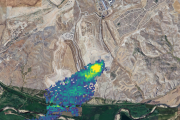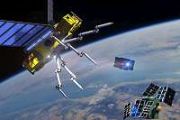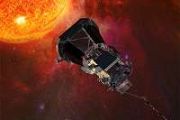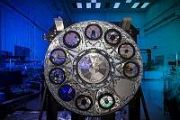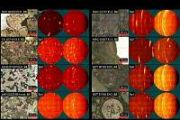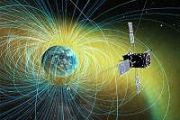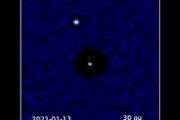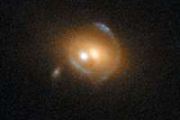
Copernical Team
Astronomers find final missing piece of galaxy cluster collision puzzle
 Astronomers have a model of how galaxy cluster collisions go through different stages, taking on various shapes. A blunt body shape turns into a sharp cone, which turns into a tongue-like shape. The first and last have been observed many times, but the sharp cone was always missing. Until now. Publication in Astronomy and Astrophysics.
Most galaxies live in clusters: groups of hundreds or
Astronomers have a model of how galaxy cluster collisions go through different stages, taking on various shapes. A blunt body shape turns into a sharp cone, which turns into a tongue-like shape. The first and last have been observed many times, but the sharp cone was always missing. Until now. Publication in Astronomy and Astrophysics.
Most galaxies live in clusters: groups of hundreds or New technique reveals the age of massive Southern Cross star
 An international team of astronomers from Australia, the United States and Europe has for the first-time unlocked the interior structure of Beta Crucis - a bright blue giant star that features on the flags of Australia, Brazil, New Zealand, Papua New Guinea and Samoa.
With an entirely new approach, the team led by Dr Daniel Cotton, found the star to be 14.5 times as massive as the Sun and
An international team of astronomers from Australia, the United States and Europe has for the first-time unlocked the interior structure of Beta Crucis - a bright blue giant star that features on the flags of Australia, Brazil, New Zealand, Papua New Guinea and Samoa.
With an entirely new approach, the team led by Dr Daniel Cotton, found the star to be 14.5 times as massive as the Sun and Simulated Webb Images of Quasar and Galaxy Surrounding Quasar
 Very distant, active supermassive black holes are the brightest beacons in the universe. Known as quasars, these behemoths are surrounded by equally distant galaxies. In recent decades, researchers have gone on a cosmic treasure hunt and identified the three most distant quasars known over the last three years - each more than 13 billion light-years from Earth. Astronomers theorize that it can t
Very distant, active supermassive black holes are the brightest beacons in the universe. Known as quasars, these behemoths are surrounded by equally distant galaxies. In recent decades, researchers have gone on a cosmic treasure hunt and identified the three most distant quasars known over the last three years - each more than 13 billion light-years from Earth. Astronomers theorize that it can t Gravitational waves could be key to answering why more matter was left over after Big Bang
 A team of theoretical researchers have found it might be possible to detect Q-balls in gravitational waves, and their detection would answer why more matter than anti-matter to be left over after the Big Bang, reports a new study in Physical Review Letters.
The reason humans exist is because at some time in the first second of the Universe's existence, somehow more matter was produced than
A team of theoretical researchers have found it might be possible to detect Q-balls in gravitational waves, and their detection would answer why more matter than anti-matter to be left over after the Big Bang, reports a new study in Physical Review Letters.
The reason humans exist is because at some time in the first second of the Universe's existence, somehow more matter was produced than ESO telescope images planet around most massive star pair to date
 The European Southern Observatory's Very Large Telescope (ESO's VLT) has captured an image of a planet orbiting b Centauri, a two-star system that can be seen with the naked eye. This is the hottest and most massive planet-hosting star system found to date, and the planet was spotted orbiting it at 100 times the distance Jupiter orbits the Sun. Some astronomers believed planets could not exist a
The European Southern Observatory's Very Large Telescope (ESO's VLT) has captured an image of a planet orbiting b Centauri, a two-star system that can be seen with the naked eye. This is the hottest and most massive planet-hosting star system found to date, and the planet was spotted orbiting it at 100 times the distance Jupiter orbits the Sun. Some astronomers believed planets could not exist a NASA's IXPE X-ray telescope will study neutron stars, pulsars, black holes
 NASA intends to learn more about stars, neutron stars, black holes, nebulae and other space objects by launching a new X-ray telescope satellite, the IXPE, from Florida early Thursday.
The $214 million IXPE satellite, or X-ray Polarimetry Explorer, will orbit the Earth as the first satellite dedicated to measuring the polarization of X-rays from a variety of cosmic sources, according to NA
NASA intends to learn more about stars, neutron stars, black holes, nebulae and other space objects by launching a new X-ray telescope satellite, the IXPE, from Florida early Thursday.
The $214 million IXPE satellite, or X-ray Polarimetry Explorer, will orbit the Earth as the first satellite dedicated to measuring the polarization of X-rays from a variety of cosmic sources, according to NA Planet decision that booted out Pluto is rooted in folklore, astrology
 As the new space race continues, a team of top researchers says one thing needs to be cleared up - what exactly is a planet?
In a study appearing recently in the journal Icarus, the researchers hope to set the record straight with a look at how a planet's definition has changed since the time of Galileo to the controversial decision the International Astronomical Union made in 2006 to crea
As the new space race continues, a team of top researchers says one thing needs to be cleared up - what exactly is a planet?
In a study appearing recently in the journal Icarus, the researchers hope to set the record straight with a look at how a planet's definition has changed since the time of Galileo to the controversial decision the International Astronomical Union made in 2006 to crea Russia strikes deal with NASA for first cosmonaut on SpaceX flight
 Russia's only active female cosmonaut, Anna Kikina, will make her first trip into space in fall 2022 as the first Russian to fly on a SpaceX Crew Dragon capsule, Russia's space agency announced Wednesday on Twitter.
Dmitry Rogozin, director general of Russia's Roscosmos agency, said his program has pledged a seat of a Russian Soyuz capsule to an American astronaut in return.
Rogozin
Russia's only active female cosmonaut, Anna Kikina, will make her first trip into space in fall 2022 as the first Russian to fly on a SpaceX Crew Dragon capsule, Russia's space agency announced Wednesday on Twitter.
Dmitry Rogozin, director general of Russia's Roscosmos agency, said his program has pledged a seat of a Russian Soyuz capsule to an American astronaut in return.
Rogozin Russia's cosmos town, an isolated relic of Soviet glory
 Malik Mutaliyev walks by an abandoned amusement park in wintry Baikonur, a secretive town in Kazakhstan's inhospitable steppe that appeared alongside the eponymous Baikonur Cosmodrome where the Soviet Union's space programme rose to glory.
"Our town has lived through a lot: Perestroika, the fall of the Soviet Union, electricity shortages. We've been through it all," says the 67-year-old form
Malik Mutaliyev walks by an abandoned amusement park in wintry Baikonur, a secretive town in Kazakhstan's inhospitable steppe that appeared alongside the eponymous Baikonur Cosmodrome where the Soviet Union's space programme rose to glory.
"Our town has lived through a lot: Perestroika, the fall of the Soviet Union, electricity shortages. We've been through it all," says the 67-year-old form Blue Origin flight with Alan Shephard daughter delayed by weather
 A Blue Origin flight due to include the daughter of the first American to travel to space has been delayed by two days because of forecasts of bad weather, the company said Wednesday.
The flight was originally scheduled for Thursday but because of winds forecast for both that day and Friday it will now aim to lift off on Saturday at 8:45 am (1445 GMT) from West Texas.
Laura Shepard Churc
A Blue Origin flight due to include the daughter of the first American to travel to space has been delayed by two days because of forecasts of bad weather, the company said Wednesday.
The flight was originally scheduled for Thursday but because of winds forecast for both that day and Friday it will now aim to lift off on Saturday at 8:45 am (1445 GMT) from West Texas.
Laura Shepard Churc 









